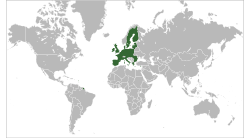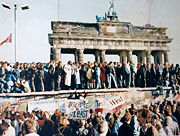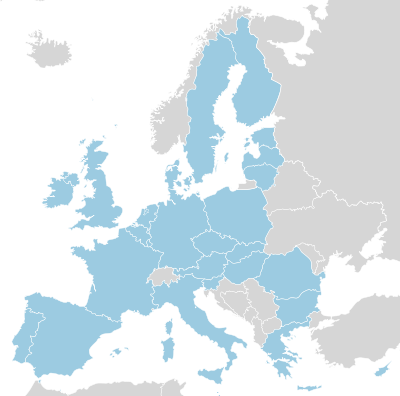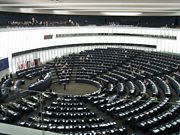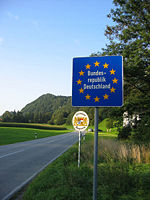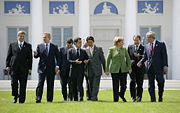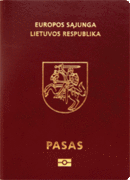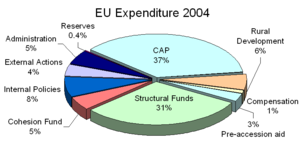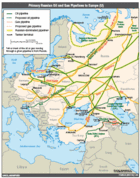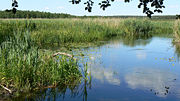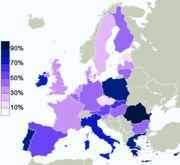European Union
2008/9 Schools Wikipedia Selection. Related subjects: Politics and government
|
European Union
|
||||||
|---|---|---|---|---|---|---|
|
||||||
| Motto: In varietate concordia (Latin) "United in diversity" |
||||||
| Anthem: Ode to Joy (orchestral) |
||||||
|
|
||||||
| Political centres | Brussels Strasbourg Luxembourg |
|||||
| Official languages |
23
|
|||||
| Demonym | European | |||||
| Member states |
27
|
|||||
| Government | Sui generis | |||||
| - | Commission | José Manuel Barroso (EPP) | ||||
| - | Parliament | Hans-Gert Pöttering (EPP) | ||||
| - | Council | Slovenia | ||||
| - | European Council | Janez Janša (EPP) | ||||
| Formation | ||||||
| - | Paris Treaty | 18 April 1951 | ||||
| - | Rome Treaty | 25 March 1957 | ||||
| - | Maastricht Treaty | 7 February 1992 | ||||
| Area | ||||||
| - | Total | 4,324,782 km² ( 7th¹) 1,669,807 sq mi |
||||
| - | Water (%) | 3.08 | ||||
| Population | ||||||
| - | 2008 estimate | 497,198,740 ( 3rd¹) | ||||
| - | Density | 114/km² ( 69th¹) 289/sq mi |
||||
| GDP ( PPP) | 2007 ( IMF) estimate | |||||
| - | Total | $14,953 billion ( 1st¹) | ||||
| - | Per capita | $28,213 ( 14th¹) | ||||
| GDP (nominal) | 2007 ( IMF) estimate | |||||
| - | Total | $16,574 billion ( 1st¹) | ||||
| - | Per capita | $33,482 ( 13th¹) | ||||
| Currency |
13
|
|||||
| Time zone | ( UTC+0 to +2) | |||||
| - | Summer ( DST) | ( UTC+1 to +3) | ||||
| Internet TLD | .eu | |||||
| 1 | If listed among entities with traditional nation state status. | |||||
The European Union (EU) is a political and economic community of twenty-seven member states, located primarily in Europe. It was established in 1993 by the Treaty of Maastricht, adding new areas of policy to the existing European Community founded in 1957.
With almost 500 million citizens the EU is generating an estimated 33% share of the world's nominal gross domestic product (US$16.6 trillion) in 2007. The EU comprises a single market created by a system of laws which apply in all member states, guaranteeing the freedom of movement of people, goods, services and capital. Fifteen member states have adopted a common currency, the euro. Passport control between many members has been abolished under the Schengen Agreement. The EU maintains common trade and agricultural policies, and a regional development policy. It has developed a role in foreign and security policies, and in justice and home affairs. The EU represents its members in the World Trade Organization and attends at G8 summits and at the United Nations. Twenty-one EU countries are members of NATO.
The functioning of the EU involves a hybrid of intergovernmentalism and supranationalism. Particularly the need for modereration of the single market has prompted the establishment of bodies capable of making decisions without the consent of national governments. The exact distribution of competences between member states and Union is explicitly defined in the proposed Treaty of Lisbon.
Important institutions and bodies of the EU include the European Commission, the Council of the European Union, the European Court of Justice, the European Central Bank, and the European Parliament which citizens elect every five years.
History
European Coal and Steel Community
The political climate after the end of World War II favoured Western European unity, seen by many as an escape from the extreme forms of nationalism which had devastated the continent. One of the first successful proposals for European cooperation came in 1951 with the European Coal and Steel Community. This had the aim of bringing together control of the coal and steel industries of its member states, principally France and West Germany. This was with the aim that war between them would not then be possible, as coal and steel were the principal resources for waging war. The Community's founders declared it "a first step in the federation of Europe"", with the hope that this would enable Europe to pursue the development of Africa. The other founding members were Italy, and the three Benelux countries: Belgium, the Netherlands, and Luxembourg.
European Communities
Two additional communities were created in 1957: the European Economic Community (EEC) establishing a customs union, and the European Atomic Energy Community (Euratom) for cooperation in developing nuclear energy. In 1967 the Merger Treaty created a single set of institutions for the three communities, which were collectively referred to as the European Communities, although more commonly just as the European Community (EC).
In 1973 the European Communities enlarged to include Denmark, Ireland and the United Kingdom. Norway had negotiated to join at the same time but a referendum rejected membership and so it remained outside.
The first direct, democratic elections of members of the European Parliament were held in 1979. They were the first European elections to be held, allowing citizens to elect 410 MEPs to the European Parliament, and also the first international election in history.
Greece, Spain and Portugal joined in the 1980s. The Schengen Agreement in 1985 created largely open borders without passport controls between most member states. In 1986 the European flag began to be used and leaders signed the Single European Act. This revised the way community decision making operated to take account of its greater membership, aimed to further reduce trade barriers and introduce greater European Political Cooperation.
European Union
In 1990 after the fall of the Iron Curtain, the former East Germany became part of the Community as part of a newly reunited Germany. With enlargement toward eastern Europe on the agenda, the Copenhagen criteria for candidate members to join the European Union were agreed.
The Maastricht Treaty came into force on 1 November 1993. Maastricht established a revised structure and the name 'European Community' officially replaced the earlier 'European Communities'. The European Community now formed one of three pillars of the new European Union, which included co-operation in matters of foreign policy and home affairs. The term European Union generally replaced the term European Community, which will be abolished by the Treaty of Lisbon along with the pillar system.
Austria, Sweden and Finland joined in 1995. The Amsterdam Treaty in 1997 amended the Maastricht treaty in areas such as democracy and foreign policy. Amsterdam was followed by the Treaty of Nice in 2001, which revised the Rome and Maastricht treaties to allow the EU to cope with further enlargement to the east.
In 2002, twelve member states adopted the euro as a single currency. Since then, the Eurozone has increased to encompassing fifteen countries. In 2004, the EU saw its biggest enlargement to date when ten new countries, most of which former parts of the Eastern Bloc, acceded the Union. Three years later, two more joined.
A treaty establishing a constitution for the EU was signed in Rome in 2004, intended to replace all previous treaties with a single document. However, it never completed ratification after rejection by French and Dutch voters in referenda. In 2007, it was agreed to replace that proposal with a new Reform Treaty, that would amend rather than replace the existing treaties. This treaty was signed on 13 December 2007 in Lisbon and is known as the Lisbon treaty. It will come in effect in January 2009 if ratified by that date.
Member states
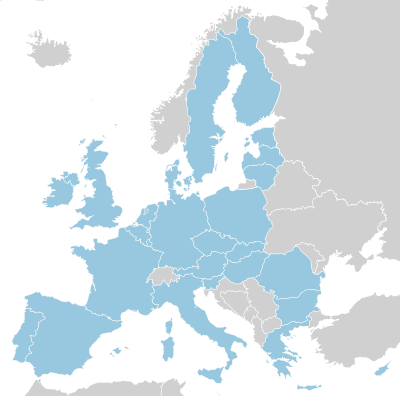 |
The European Union is composed of 27 independent sovereign countries which are known as member states: Austria, Belgium, Bulgaria, Cyprus, the Czech Republic, Denmark, Estonia, Finland, France, Germany, Greece, Hungary, Ireland, Italy, Latvia, Lithuania, Luxembourg, Malta, the Netherlands, Poland, Portugal, Romania, Slovakia, Slovenia, Spain, Sweden, and the United Kingdom. There are three official candidate countries, Croatia, FYROM and Turkey; the western Balkan countries of Albania, Bosnia and Herzegovina, Kosovo, Montenegro and Serbia are officially recognised as potential candidates.
To join the EU, a country must meet the Copenhagen criteria, defined at the 1993 Copenhagen European Council. These require a stable democracy which respects human rights and the rule of law; a functioning market economy capable of competition within the EU; and the acceptance of the obligations of membership, including EU law. Evaluation of a country's fulfilment of the criteria is the responsibility of the European Council. The current framework does not specify how a country could exit the Union (although Greenland withdrew in 1985), but the proposed Treaty of Lisbon contains a formal procedure for withdrawing.
Four Western European countries that have chosen not to join the EU have partly committed to the EU's economy and regulations: Iceland, Liechtenstein and Norway are a part of the single market through the European Economic Area, and Switzerland has similar ties through bilateral treaties. The relationships of european microstates Andorra, Monaco, San Marino, Liechtenstein and Vatican City can include use of the euro and other co-operation.
Geography
The territory of the EU consists of the combined territories of its 27 member states with some exceptions outlined below. The territory of the EU is not the same as that of Europe, as parts of the continent are outside the EU, such as Switzerland, Norway and European Russia. Some parts of member countries are not part of the EU, despite forming part of the European continent (for example the Channel Islands and Faroe Islands). Several territories associated with member states that are outside geographic Europe are also not part of the EU (such as Greenland, Aruba, the Netherlands Antilles and all the non-European territories associated with the United Kingdom). Some overseas territories are part of the EU even if they are not geographically part of Europe, such as the Azores, the Canary Islands, French Guiana, Guadeloupe, Madeira, Martinique, Réunion, Saint Barthélemy and Saint Martin.
The EU's member states cover a combined area of 4,422,773 square kilometres (1,707,642 sq mi). The total territory of the EU is larger than all but six countries and its highest peak is Mont Blanc in the Graian Alps, 4807 metres above sea level. The landscape, climate and economy of the EU are influenced by its coastline, which is 69,342 kilometres (43,087 mi) long. The EU has the world's second longest coastline, after Canada. The combined member states share land borders with 21 non-member states for a total of 12,441 kilometres (7,730 mi), the fifth longest border in the world.
Including the overseas territories of member states, the EU experiences most types of climate from Arctic to tropical, rendering meteorological averages for the EU as a whole meaningless. In practice, the majority of the population lives either in areas with a Mediterranean climate (Southern Europe), a temperate maritime climate (Western Europe), or a warm summer continental or hemiboreal climate (Eastern Europe).
Governance
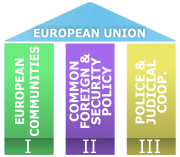
The EU is based on a series of treaties. These first established the European Community and the EU, and then made amendments to those founding treaties. The treaties lay down the broad policy goals of the organisation and establish institutions with the necessary legal powers to implement those goals. These legal powers include the ability to enact legislation which can directly affect all member states and their inhabitants (the principle of ' direct effect'). National courts are required to enforce the EU treaties and the laws enacted under them, as membership of the organisation obliges them to do so. In the case of a conflict where a law stemming from EU legislation conflicts with another national law, the EU law is considered to take precedence (principle of ' Supremacy'). Decisions regarding EU legislation may be referred to the European Court of Justice by national courts. The EU is regulated by a number of institutions, primarily the Council of the European Union, the European Commission, and European Parliament.
The EU is often described as being divided into three areas of responsibility, called ' pillars'. The original European Community policies form the first pillar, while the second consists of Common Foreign and Security Policy. The third pillar originally consisted of Justice and Home Affairs, however owing to changes introduced by the Amsterdam and Nice treaties, it currently only consists of Police and Judicial Co-operation in Criminal Matters. Broadly speaking, the second and third pillars can be described as the intergovernmental pillars because the supranational institutions of the Commission, Parliament and the Court of Justice play less of a role or none at all, while the lead is taken by the intergovernmental Council of Ministers and the European Council. Most activities of the EU come under the first, Community pillar. This is mostly economically oriented and the supranational institutions have more influence.
Commission
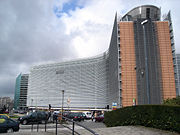
The European Commission acts as the EU's executive arm and is responsible for initiating legislation and the day-to-day running of the EU. It is intended to act solely in the interest of the EU as a whole, as opposed to the Council which consists of leaders of member states who reflect national interests. The commission is also seen as the motor of European integration. It is currently composed of 27 commissioners for different areas of policy, one from each member state.
The President of the Commission and all the other commissioners are nominated by the Council. Appointment of the Commission President, and also the Commission in its entirety, have to be confirmed by Parliament.
Council
The Council of the European Union forms one half of the EU's legislature. It is an organised platform where national ministers responsible for the area of policy being addressed, meet. Although the Council meets in different compositions, it is considered to be one single body. In addition to its legislative functions, the Council also exercises executive functions in relations to the Common Foreign and Security Policy.
The rotating Presidency of the EU Council is taken by each member state in turn for a period of six months, during which the relevant member chairs most meetings of the Council. The member state holding the presidency typically uses it to drive and focus on a limited number of policy areas; such as various types of reform, enlargement or external relations with a specific part of the world.
Highest-ranking political leadership in the EU is provided by the European Council (not to be mistaken for the Council of Europe), which is the EU Council when composed of heads of government of the member states (e.g. the prime minister or President) plus the President of the Commission. The European Council meets on at least four summits a year, and is lead by the head of government of the rotating presidency.
Parliament
The other half of the EU's legislature is the European Parliament. The 785 Members of the European Parliament (MEPs) are directly elected by EU citizens every five years. Although MEPs are elected on a national basis, they sit according to political groups rather than their nationality. Each country has a set number of seats. The Parliament and the Council form and pass legislation jointly, using codecision, in certain areas of policy. This procedure will extend to many new areas under the proposed Treaty of Lisbon, and hence increase the power and relevance of the Parliament. The Parliament also has the power to reject or censure the Commission and the EU budget. The President of the European Parliament carries out the role of speaker in parliament and represents it externally. The president and vice presidents are elected by MEPs every two and a half years.
Legal System
Although the Treaties are the ultimate source of EU Law, there are a number of legislative instruments available to the EU institutions. The three main instruments are Regulations, Directives and Decisions. There is no formal hierarchy regarding the three types.
Regulations are legislative acts which become law in all member states the moment they come into force, without the requirement for any implementing measures to have been taken by member states. Once in force their contents automatically override conflicting domestic provisions, as a result of having direct effect in the national law of the member states.
Directives require member states to achieve a certain result while leaving them discretion as to how to achieve the result within a certain time period. Directives are generally used where it is thought preferable to leave the precise details of legislative implementation to national governments. Once the stated time period has passed, under certain conditions provisions within a Directive may have direct effect in national law against Member States.

Decisions offer an alternative to the two above modes of legislation. The Council and the Commission may publish in the official journal a decision, notified to a particular addressee, such as an individual trader or a company. Decisions will be found most commonly in Competition Law, or on rulings on State Aid, and can be challenged by the addressee under certain circumstances before the EU courts.
The EU's legal system contains a multiplicity of legislative procedures used to enact the above legislation. The treaties provide the basis for all legislation and lay down the different ways of adopting legislation for different policy areas. A common feature of the EU's legislative procedures is that almost all legislation must be proposed by the Commission, rather than member states or European parliamentarians. The two most common procedures are co-decision, under which the European Parliament can veto proposed legislation, and consultation, under which Parliament is only permitted to give an opinion which can be ignored by European leaders. In most cases legislation must be agreed by the council. See: European Union legislative procedure.
Courts
The judicial branch of the EU consists of the European Court of Justice (ECJ) and the Court of First Instance (to be renamed the "General Court" upon the entering into force of the Treaty of Lisbon). Together they interpret and apply the treaties and the law of the EU. The Court of First Instance mainly deals with cases taken by individuals and companies directly before the EU's courts, and the ECJ primarily deals with cases taken by member states, the institutions and cases referred to the EU's courts by the courts of member states. Decisions from the Court of First Instance can be appealed to the Court of Justice but only on a point of law.
National courts within the Member States also play a key role in the EU as enforcers of EU law, and a "spirit of cooperation" between EU and national courts is laid down in the Treaties. National courts can apply EU law in domestic cases, and if they require clarification on the interpretation or validity of any EU legislation related to the case it may make a reference for a preliminary ruling to the ECJ. The right to declare EU legislation invalid however is reserved to the EU courts.
Politics

Two major political issues for the EU are European integration and enlargement. Enlargement, the accession of new states to the EU, is a highly politicised issue. Supporters argue it aids democracy in new members, as well as supporting the European economy as a whole. Opponents fear the EU is expanding beyond its current political capabilities, and/or cultural boundaries. Public opinion, and hence political party viewpoint, has been more skeptical towards enlargement since the simultaneous accession of 10 members in 2004. This is most acute in relation to the candidacy of Turkey.
Integration is another political issue, where the public view is sometimes that national interest conflicts with that of the EU. The aim of increasing harmonisation between states has meant that national powers have been transferred to the European level. This is criticised by eurosceptics who fear the loss of national sovereignty. In 2004 the European Constitution was agreed between national leaders and the EU institutions. However it did not come into force after it was rejected in referenda in two countries, with the prospect of further rejections had attempts at ratification continued. In October 2007 European leaders finalised a new Treaty of Lisbon which contains much of the now defunct constitution, without the latter's constitutional terms and elements.
The treaty is expected to come into force in 2009. If ratified it will introduce more majority voting in the Council and increase the powers of the European Parliament. The treaty also proposes to abolish the EU's pillar system. More aspects of foreign policy will now be subject to the supranational, as opposed to intergovernmental, institutions.
Justice, freedom and security
Much of the EU's competence in the justice and home affairs area originates from the signing of the Schengen Agreement in 1985 on gradual abolition of border controls between six of the then ten European Community member states. In order to implement the Schengen Agreement, the signatory states included measures designed to compensate for the effect of reduced border controls in the areas of asylum, immigration and criminal justice. The Maastricht Treaty transferred the Schengen acquis to the EU (title IV of the Maastricht Treaty as originally enacted).
Additional competencies were assigned to the EU by the Maastricht Treaty to facilitate the freedom of movement of people by adopting common rules in civil matters, such as contract and family law. The Maastricht Treaty also introduced the concept of citizenship of the European Union, which is complementary to national citizenship.
Amendments to these treaties by the Amsterdam Treaty added a new aim of the EU as the creation of an "area of Justice, Freedom and Security". That treaty also made it easier to pass laws in the justice and home affairs area and more difficult for member states to veto them. It also increased the powers of the European Parliament in relation to Justice and Home affairs' measures, with decisions in certain matters coming to be decided by codecision. Recent legislation includes the European Arrest Warrant and directives on family law.
The EU has established agencies to co-ordinate its actions in the justice and home affairs area: Europol for co-operation of police forces, Eurojust for co-operation between prosecutors, and Frontex for co-operation between border control authorities. The EU also operates the Schengen Information System which provides a common database for police and immigration authorities.
Fundamental rights
The EU has developed a role in human rights protection. Prohibitions against sexual and nationality discrimination have a long standing in the treaties. The Amsterdam Treaty supplemented these, by supporting further legislation against discrimination based on race, religion, disability, age and sexual orientation. Using these powers the EU has enacted legislation on sexual discrimination in the work-place, age discrimination and racial discrimination. All EU states have abolished capital punishment for all crimes and the EU has been a prominent campaigner for global abolition.
Signing the 1950 European Convention on Human Rights (ECHR) is a condition for EU membership, however the institutions of the EU are not covered by this. As the EU was not capable of signing the ECHR without a treaty change, the EU drew up the Charter of Fundamental Rights. The charter consolidated not only the rights of the ECHR but those of other UN and EU agreements, covering economic, political and social rights including "third generation" rights such as good governance and a clean environment. Although it was proclaimed in 2000, it has no legal force at present (2007). Under the Reform Treaty, the Charter would become legally binding and the EU would accede to the ECHR, which would make the European Court of Human Rights, currently totally separate from the EU, the highest court in the EU for Human Rights, above the EU's Court of Justice. Even without joining, the Court of Justice and Court of Human Rights co-operate to ensure their case-law does not conflict, thus the Court of Justice already treats the ECHR as though it was part of EU law.
Foreign relations
The foreign relations of the EU are primarily dealt with through the Common Foreign and Security Policy (CFSP). Co-operation in international trade negotiations, under the Common Commercial Policy, dates back to the establishment of the Community in 1957. The CFSP itself has its origins in the formation of European Political Co-operation in 1970. European Political Co-operation was an informal consultation process between member states on foreign policy matters, with the aim of forming common policies. It was formally introduced into the then European Community by the Single European Act and subsequently renamed as the "Common Foreign and Security Policy" by the Maastricht Treaty.
The Maastricht Treaty gives the Common Foreign and Security Policy the aims of promoting both the EU's own interests and those of the international community as a whole. This includes promoting international co-operation, respect for human rights, democracy and the rule of law.
The Amsterdam Treaty created the office of the High Representative for the Common Foreign and Security Policy (currently held by Javier Solana) to co-ordinate the EU's foreign policy. The High Representative, in conjunction with the current Presidency, speaks on behalf of the EU in foreign policy matters and can have the task of articulating ambiguous policy positions created by disagreements among member states. The Common Foreign and Security Policy requires unanimity among the now 27 member states on the appropriate policy to follow on any particular policy. The unanimity and difficult issues treated under the CFSP makes disagreements, such as those which occurred over the war in Iraq, not uncommon.
Besides the emerging international policy of the European Union, the international influence of the EU is also felt through enlargement. The perceived benefits of becoming a member of the EU act as an incentive for both political and economic reform in states wishing to fulfil the EU's accession criteria, and are considered a major factor contributing to the reform of former Communist countries in Eastern Europe. This influence on the internal affairs of other countries is generally referred to as "soft power", as opposed to military "hard power". Finnish Prime Minister, Matti Vanhanen, cited the common foreign policy as a factor why Finland is, de facto, no longer a neutral country. It is not known if this view is shared by the leaders of the other neutral countries in the EU.
Besides the CFSP, the Commission also has its own representation in international organisations. This is primarily through the European Commissioner for External Relations, who works alongside the High Representative. In the UN the EU has gained influence in areas such as aid due to its large contributions in that field (see below). In the G8, the EU has rights of membership besides chairing/hosting summit meetings and is represented at meetings by the presidents of the Commission and the Council. In the World Trade Organisation (WTO), where all 27 member states are represented, the EU as a body is represented by Trade Commissioner Peter Mandelson.
Humanitarian aid
The European Community humanitarian aid office, or "ECHO", provides humanitarian aid from the EU to developing countries. In 2006 its budget amounted to 671 million euros, 48% of which went to the ACP countries. Counting the EU's own contributions and those of its member states together, the EU is the largest aid donor in the world.
The EU's aid has previously been criticised by the eurosceptic think-tank Open Europe for being inefficient, mis-targeted and linked to economic objectives. Furthermore, some charities have claimed European governments have inflated the amount they have spent on aid by incorrectly including money spent on debt relief, foreign students, and refugees. Under the de-inflated figures, the EU did not reach its internal aid target in 2006 and the EU would not reach the international target of 0.7% of GNP until 2015. However only a few countries have reached that target. In 2005 EU aid was 0.34% of the GNP which was higher than that of the United States and Japan. The current commissioner for aid, Louis Michel, has called for aid to be delivered more rapidly, to greater effect, and on humanitarian principles.
Military and defence
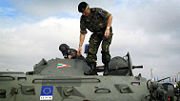
Member states are responsible for their own territorial defence. Many EU members are also members of NATO. The Western European Union (WEU) is a European security organisation related to the EU. In 1992, the WEU's relationship with the EU was defined, when the EU assigned it the " Petersberg tasks" (humanitarian missions such as peacekeeping and crisis management). These tasks were later transferred from the WEU to the EU by the Amsterdam Treaty; they formed part of the new CFSP and the European Security and Defence Policy. Elements of the WEU are currently being merged into the EU's CFSP, and the President of the WEU is currently CFSP High Representative.
Following the Kosovo War in 1999, the European Council agreed that "the Union must have the capacity for autonomous action, backed by credible military forces, the means to decide to use them, and the readiness to do so, in order to respond to international crises without prejudice to actions by NATO." To that end, a number of efforts were made to increase the EU's military capability, notably the Helsinki Headline Goal process. After much discussion, the most concrete result was the EU Battlegroups initiative, each of which is planned to be able to deploy quickly about 1500 men. EU forces have been deployed on peacekeeping missions from Africa to the former Yugoslavia and the Middle East. EU military operations are supported by a number of bodies, including the European Defence Agency, satellite centre and the military staff.
Economic policy

Since its origin, the EU has established a single economic market across the territory of all its members. Currently a single currency is in use between the 15 members of the eurozone. Considered as a single economy, the EU generated an estimated nominal gross domestic product (GDP)of US$16,600 billion in 2007, amounting to 31% of the world's total economic output, which makes it the largest economy in the world. It is also the largest exporter of goods, the second largest importer, and the biggest trading partner to several countries such as the United States, and China. 163 of the top 500 largest corporations measured by revenue ( Fortune Global 500) have their headquarters in the EU. In May 2007 unemployment in the EU stood at 7% while investment was at 21.4% of GDP, inflation at 2.2% of GDP and public deficit at -0.9% of GDP.
Single market
The Treaty of Rome originally created a European Economic Community. This outlined the staged development of a single market, starting with the introduction of a customs union between the signatories. This became the European Community, one part of the European Union, which still has a primary task of creating and maintaining the single market. In particular it seeks to guarantee four freedoms, which relate to ensuring the free movement of goods, capital, people and services within the area.
The principle of free movement of goods ensures goods can be taken anywhere within the whole market without being subject to barriers or obstacles. This freedom has both an internal and external dimension. Internally, goods must not be subjected to customs duties, discriminatory taxes or measures restricting import quantities between member countries. Externally, goods entering the internal market will be granted freedom after paying the Common Customs Tariff.
Free movement of capital is intended to permit movement of investments such as property purchases and buying of shares between countries. Until the drive towards Economic and Monetary Union the development of the capital provisions had been slow. Post-Maastricht there has been a rapidly developing corpus of ECJ judgments regarding this initially neglected freedom. The free movement of capital is unique insofar as that it is granted equally to non-member countries.
The free movement of persons means citizens can move freely between member states to live, work, study or retire in another country. This required the lowering of administrative formalities and recognition of professional qualifications of other states. Traditionally the economically active were granted a much greater level of freedom than others. The extension to the non-economically active was first recognised in 1999 when the concept of Community Citizenship was introduced to the EU. In addition to extending the scope of the free movement of persons, it also grants certain social and political rights to the citizens of the EU.
The free movement of services and of establishment allows self-employed persons to move between member states in order to provide services on a temporary or permanent basis. Services account for between sixty and seventy percent of GDP, although legislation is not as developed as in other sectors. This has been addressed by the recently passed Directive on services in the internal market which aims to liberalise this area of the market. According to the Treaty the provision of services is a residual freedom that only applies if no other freedom is being exercised.
The freedoms are not absolute in nature. Member states may interfere with their exercise on the specific grounds laid down in the Treaty, or can rely on the case law of the European Courts for more general justifications. For example, the Treaty allows member states to restrict movements that would pose a real threat to public policy or public security. In the absence of Community legislation it is for the member states to decide the scope of the exceptions. The European Courts will arbitrate as to whether the actions of the member state are proportionate and in conformity with Community law. The freedoms are extended to the non-member states of Iceland, Liechtenstein and Norway via the European Economic Area.Half the trade in the EU is covered by legislation harmonised by the EU.
Monetary union

A single currency for the EU has been an official objective since 1969 and work began in 1990 on Economic and Monetary Union. Nine years later the euro was launched in eleven of the then fifteen member states as an accounting currency, meaning that national currencies remained in use but with exchange rates locked to the euro. On 1 January 2002, euro notes and coins were issued and the national currencies were phased out. Eurozone membership increased to twelve in 2002 and now fifteen countries use the euro as their sole official currency. Slovenia adopted the Euro on the 1 January 2007, Cyprus and Malta on the 1 January 2008. All other EU members except Denmark and the United Kingdom have agreed to join as a condition of being members of the EU and dates for this will be set when economic conditions have been met. Public opinion in Denmark currently favours joining. Sweden has pointedly failed to take necessary economic steps. A number of other countries outside the EU, such as Montenegro, also use the euro unofficially. The euro, and the monetary policies of those who have adopted it, are under the control of the European Central Bank (ECB). There are twelve other currencies used in the EU.
The euro is designed to help build the single market by, for example: easing travel of citizens and goods, eliminating exchange rate problems, providing price transparency, creating a single financial market, price stability, low interest rates, having a currency used internationally and protected against shocks by the large amount of internal trade within the eurozone. It is also intended as a political symbol of integration and stimulus for more. In recent years holdings of the euro have grown, and there is some speculation that if the eurozone continues to enlarge, and/or the U.S. dollar continues to fall, the euro could become the main world reserve currency.
Competition
The EU operates a competition policy intended to ensure undistorted competition within the single market. The Commission as the competition regulator for the single market is responsible for antitrust issues, approving mergers, breaking up cartels, working for economic liberalisation and preventing state aid.
The Competition Commissioner, currently Neelie Kroes, is one of the most powerful positions in the Commission, notable in effecting trans-national corporations. For example, in 2001 the Commission for the first time prevented a merger between two companies based in the United States which had already been approved by their national authority. Another high profile case, European Union v. Microsoft, resulted in the Commission fining Microsoft over €777 million following nine years of legal action.
In negotiations on the Treaty of Lisbon, French President Nicolas Sarkozy succeeded in removing the words "free and undistorted competition" from the treaties. However, the requirement is maintained in an annex and it is unclear whether this will have any practical effect on EU policy.
Budget
The EU had an agreed budget of €116 billion for the year 2007, and €862 billion for the period 2007-2013; this represents around 1% of the EU's combined GDP. By comparison, the UK's expenditure for 2004 was estimated to be €759 billion, and France was estimated to have spent €801 billion. In 1960, the then "EU" ( EEC) budget was 0.03% of GDP.
The largest single expenditure item is the Common Agricultural Policy (CAP) at around 45% of the total budget. The second largest element is the regional policy, at 30%. Foreign policy consumes 8%, administration 6%, research 5%.
Development policy
Agriculture
The Common Agricultural Policy (CAP) is one the oldest policies of the European Community and was one of its core aims. The policy has the objectives of increasing agricultural production, providing certainty in food supplies, ensuring a high quality of life for farmers, stabilising markets and ensuring reasonable prices for consumers (article 33 of the Treaty of Rome). It was, until recently, operated by a system of subsidies and market intervention. Until the 1990s the policy accounted for over 60% of the then European Community's annual budget, and still accounts for around 35%.
The policy's price controls and market interventions led to considerable overproduction, resulting in so-called butter mountains and wine lakes. These were intervention stores of produce bought up by the Community to maintain minimum price levels. In order to dispose of surplus stores, they were often sold on the world market at prices considerably below Community guaranteed prices, or farmers were offered subsidies (amounting to the difference between the Community and world prices) to export their produce outside the Community. This system has been criticised for under-cutting farmers in the developing world. The overproduction has also been criticised on environmental grounds in that it encourages environmentally unfriendly intensive farming methods. Supporters of CAP say that the economic support which it gives to farmers provides them with a reasonable standard of living, in what would otherwise be an economically unviable way of life. However, the EU's small farmers only receive 8% of CAP's available subsidies.
Since the beginning of the 1990s the CAP has been subject to a series of reforms. Initially these reforms included the introduction of Set-aside in 1988, where a proportion of farm land was deliberately withdrawn from production, milk quotas (by the McSharry reforms in 1992) and more recently, the 'de-coupling' (or disassociation) of the money farmers receive from the EU and the amount they produce (by the Fischler reforms in 2004). It is intended to move away from subsidy payments linked to specific produce, toward direct payments based on farm size. This is intended to have the effect of allowing the market to dictate production levels while maintaining agricultural income levels. The most recent reform entailed the abolition of the EU's sugar regime which previously involved the carving up of the sugar market between member states and certain African-Caribbean nations with a privileged relationship with the EU.
Energy
The EU has been a legislative power in the area of energy policy for most of its existence: this has its roots in the original European Coal and Steel Community. The introduction of a mandatory and comprehensive European energy policy was approved at the meeting of the European Council in October 2005, and the first draft policy was published in January 2007.
The Commission has five key points in its energy policy: increase competition in the internal market, encourage investment and boost interconnections between electricity grids; diversify energy resources with better systems to respond to a crisis; establish a new treaty framework for energy co-operation with Russia while improving relations with energy-rich states in Central Asia and North Africa; use existing energy supplies more efficiently while increasing use of renewable energy; and finally increase funding for new energy technologies.
The EU currently imports 82% of its oil and 57% of its gas, making it the world's leading importer of these fuels. There are concerns that the EU is largely dependent on other countries, primarily Russia, for its energy. This concern has grown following a series of clashes between Russia and its neighbours, threatening the flow of gas. As a result the EU is attempting to diversify its energy supply.
Infrastructure
The EU is working to improve cross-border infrastructure within the EU, for example through the Trans-European Networks (TEN). Projects under TEN include the Channel Tunnel, LGV Est, the Fréjus Rail Tunnel, the Oresund Bridge and the Brenner Base Tunnel. In 2001 it was estimated that by 2010 the network would cover: 75,200 km of roads; 78,000 km of railways; 330 airports; 270 maritime harbours; and 210 internal harbours.
The developing European transport policies will increase the pressure on the environment in many regions by the increased transport network. In the pre-2004 EU members, the major problem in transport deals with congestion and pollution. After the recent enlargement, the new states that joined since 2004 added the problem of solving accessibility to the transport agenda. The Polish road network in particular was in poor condition: at Poland's accession to the EU, 4,600 roads needed to be upgraded to EU standards, demanding approximately 17 billion euros.
Another infrastructure project is the Galileo positioning system. Galileo is a proposed Global Navigation Satellite System, to be built by the EU and launched by the European Space Agency (ESA), and is to be operational by 2010. The Galileo project was launched to reduce the EU's dependency on the US-operated Global Positioning System, which will extend to nations outside the EU. It has been criticised by some due to costs, delays, and the perception of redundancy due to the existing GPS system.
Regional development

There are substantial economical disparities across the EU. Even corrected for purchasing power, the difference between the richest and poorest regions (NUT-2 and NUT-3 of the Nomenclature of Territorial Units for Statistics) is about a factor of ten. On the high end Frankfurt has €68,751 PPP per capita, Paris €67,980, and Inner London €65,138, while Romania's Nord-Est has €5,070 PPP per capita and Bulgaria's Severozapaden has €5,502 PPP per capita. Compared to the EU average, the United States GDP per capita is 35% higher and the Japanese GDP per capita is approximately 15% higher.
There are a number of Structural Funds and Cohesion Funds to support development of underdeveloped regions of the EU. Such regions are primarily located in the new member states of eastern Europe. Several funds provide emergency aid, support for candidate members to transform their country to conform to the EU's standard ( Phare, ISPA, and SAPARD), and support to the former USSR Commonwealth of Independent States ( TACIS). TACIS has now become part of the worldwide EuropeAid programme. The EU Seventh Framework Programme (FP7) sponsors research conducted by consortia from all EU members to work towards a single European Research Area.
Environment
The first environmental policy of the European Community was launched in 1972. Since then it has addressed issues such as acid rain, the thinning of the ozone layer, air quality, noise pollution, waste and water pollution. The Water framework directive is an example of a water policy, aiming for rivers, lakes, ground and coastal waters to be of "good quality" by 2015. Wildlife is protected through the Natura 2000 programme and covers 30,000 sites throughout Europe. In 2007, the Polish government sought to build a motorway through the Rospuda valley, but the Commission has been blocking construction as the valley is a wildlife area covered by the programme.
The REACH regulation was a piece of EU legislation designed to ensure that 30,000 chemicals in daily use are tested for their safety. In 2006, toxic waste spill off the coast of Côte d'Ivoire, from a European ship, prompted the Commission to look into legislation regarding toxic waste. With members such as Spain now having criminal laws against shipping toxic waste, the Commission proposed to create criminal sentences for "ecological crimes". Although the Commission's right to propose criminal law was contested, it was confirmed in this case by the Court of Justice.
In 2007, member states agreed that the EU is to use 20% renewable energy in the future and that is has to reduce carbon dioxide emissions in 2020 by at least 20% compared to 1990 levels. This includes measures that in 2020, one-tenth of all cars and trucks in EU 27 should be running on biofuels. This is considered to be one of the most ambitious moves of an important industrialised region to fight global warming.
At the 2007 United Nations Climate Change Conference, dealing with the successor to the Kyoto Protocol, the EU has proposed at 50% cut in greenhouse gases by 2050. The EU's attempts to cut its carbon footprint appear to have also been aided by an expansion of Europe's forests which, between 1990 and 2005, grew 10% in western Europe and 15% in Eastern Europe. During this period they soaked up 126 million metric tons of carbon dioxide, equivalent to 11% of EU emissions from human activities.
Education and research
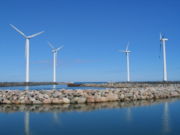
Education and science are areas where the EU's role is limited to supporting national governments. In education, the policy was mainly developed in the 1980s in programmes supporting exchanges and mobility. The most visible of these has been the ERASMUS programme, a university exchange programme which began in 1987. In its first 20 years it has supported international exchange opportunities for well over 1.5 million university and college students and has become a symbol of European student life. There are now similar programmes for school pupils and teachers, for trainees in vocational education and training, and for adult learners in the Lifelong Learning Programme 2007–2013. These programmes are designed to encourage a wider knowledge of other countries and to spread good practices in the education and training fields across the EU. Through its support of the Bologna process the EU is supporting comparable standards and compatible degrees across Europe.
Scientific development is facilitated through the EU's Framework Programmes, the first of which started in 1984. The aims of EU policy in this area are to co-ordinate and stimulate research. The independent European Research Council allocates EU funds to European or national research projects. The Seventh Framework Programme (FP7) deals in a number of areas, for example energy where it aims to develop a diverse mix of renewable energy for the environment and to reduce dependence on imported fuels.
Since January 2000 the European Commission has set its sights on a more ambitious objective, known as the European Research Area, and has extensively funded research in a few key areas. This has the support of all member states, and extends the existing financing structure of the frameworks. It aims to focus on co-ordination, sharing knowledge, ensuring mobility of researchers around Europe, improving conditions for researchers and encouraging links with business and industry as well as removing any legal and administrative barriers. The EU is involved with six other countries to develop ITER, a fusion reactor which will be built in the EU at Cadarache. ITER builds on the previous project, Joint European Torus, which is currently the largest nuclear fusion reactor in the world. The Commission foresees this technology to be generating energy in the EU by 2050. It has observer status within CERN, there are various agreements with ESA and there is collaboration with ESO. Theses organizations are not under the framework of the EU, but membership heavily overlaps between them.
Demographics
| City | City limits (2006) |
Density/km² (city limits) |
Urban area (2005) |
LUZ (2001) |
|---|---|---|---|---|
| Berlin | 3,410,000 | 3,815 | 3,761,000 | 4,935,524 |
| London | 7,512,400 | 4,761 | 9,332,000 | 11,624,807 |
| Madrid | 3,228,359 | 5,198 | 4,858,000 | 5,372,433 |
| Paris | 2,153,600 | 24,672 | 9,928,000 | 10,952,011 |
| Rome | 2,708,395 | 2,105 | 2,867,000 | 3,700,424 |
The combined population of all 27 member countries has been estimated at 495,128,529 in January 2007, this in comparison to approximately 710 million Europeans on the continent as a whole. There is some increase in population expected, primarily due to net immigration, present in most European countries.
The EU's population is 7.3% of the world total, yet the EU covers just 3% of the earth's land, amounting to a population density of 114/ km² (2006) making the EU one of the most densely populated regions of the world. One third of EU citizens live in cities of over a million people, rising to 80% living in urban areas generally. The EU is home to more global cities than any other region in the world and 16 cities with populations of over one million (using city proper figures).
Besides many large cities, the EU also includes several densely populated regions that have no single core but have emerged from the connection of several cites and are now encompassing large metropolitan areas. The largest are Rhine-Ruhr having approximately 10.5 million inhabitants (Cologne, Dortmund, Düsseldorf et al.), Randstad approx. 7 million (Amsterdam, Rotterdam, The Hague, Utrecht et al.), Frankfurt Rhein-Main Region approx. 5.8 million (Frankfurt, Wiesbaden et al.), the Flemish diamond (urban area in between Antwerp, Brussels, Leuven and Ghent), approx. 5,5 million inhabitants, and the Upper Silesian Industrial Region approx. 3.5 million ( Katowice, Sosnowiec et al.).
Languages
| Language | L1 | Total |
|---|---|---|
| English | 13% | 51% |
| German | 18% | 32% |
| French | 12% | 26% |
| Italian | 13% | 16% |
| Spanish | 9% | 15% |
| Polish | 9% | 10% |
| Romanian | 7% | 8% |
| Dutch | 5% | 6% |
| Greek | 3% | 3% |
| Swedish | 2% | 3% |
| Czech | 2% | 3% |
| Portuguese | 2% | 2% |
| Hungarian | 2% | 2% |
| Bulgarian | 2% | 2% |
| Other EU Languages | ~6% | |
| Minority Languages | ~16% | |
| L1: Native language Total: EU citizens able to conduct conversation in this language |
||
The EU has 23 official and working languages: Bulgarian, Czech, Danish, Dutch, English, Estonian, Finnish, French, German, Greek, Hungarian, Italian, Irish, Latvian, Lithuanian, Maltese, Polish, Portuguese, Romanian, Slovak, Slovenian, Spanish and Swedish. Important documents, such as legislation, are translated into every official language. The European Parliament provides translation into all languages for documents and its plenary sessions. Some institutions use only a handful of languages as internal working languages. Language policy is the responsibility of member states, but EU institutions promote the learning of other languages.
German is the most widely spoken mother tongue (about 88.7 million people as of 2006), followed by English, French and Italian. English is by far the most spoken foreign language at over half (51%) of the population, with German and French following. 56% of European citizens are able to engage in a conversation in a language other than their mother tongue. Most official languages of the EU belong to the Indo-European language family, except Estonian, Finnish, and Hungarian, which belong to the Uralic language family, and Maltese, which is a Semitic language. Most EU official languages are written in the Latin alphabet except Bulgarian, written in Cyrillic, and Greek, written in the Greek alphabet.
Besides the 23 official languages, there are about 150 regional and minority languages, spoken by up to 50 million people. Of these, only the Spanish regional languages ( Catalan, Basque and Galician) can be used in communication with the Council of the European Union, the Commission, the Economic and Social Committee, the European Parliament, the European Ombudsman and the Committee of the Regions. Although EU programmes can support regional and minority languages, the protection of linguistic rights is a matter for the individual member states.
Besides the many regional languages, a broad variety of languages from other parts of the world are spoken by immigrant communities in the member states: Turkish, Maghrebi Arabic, Russian, Urdu, Bengali, Hindi, Tamil, Ukrainian, and Balkan languages are spoken in many parts of the EU. Many older immigrant communities are bilingual, being fluent in both the local (EU) language and in that of their ancestral community. Migrant languages have no formal status or recognition in the EU or in the EU countries, although from 2007 they are eligible for support from the language teaching section of the EU's Lifelong Learning Programme 2007–2013.
Religion
The EU is a secular body, with no formal connections to any religion and no mention of religion in any current or proposed treaty. Discussion over the draft texts of the European Constitution and later the Treaty of Lisbon included proposals to mention Christianity and/or God in the preamble of the text, but the idea faced opposition and was dropped.
Emphasis on Christianity stems from this being the dominant religion in Europe, and thus of the EU. It divides between Roman Catholicism, a wide range of Protestant churches (especially in northern Europe) and Eastern Orthodox (in south eastern Europe. Other religions such as Judaism and Islam are also represented in the EU population; in 2002 the EU had an estimated Jewish population of over a million and a Muslim population in 2006 of 16 million people.
Findings by Eurostat, the EU statistics agency which monitors the religious beliefs of EU citizens as part of its Eurobarometer opinion polls, show that the majority of EU citizens have some form of belief system but that only 21% see it as important. There is increasing atheism or agnosticism among the general population in Europe, with falling church attendance and membership in many countries. The 2005 Eurobarometer showed that of the European citizens (of the 25 members at that time), 52% believed in a god, 27% in some sort of spirit or life force and 18% had no form of belief. The countries where the fewest people reported a religious belief were the Czech Republic (19%) and Estonia (16%), The most religious societies are those in Malta (95%; predominantly Roman Catholic), and Cyprus and Romania both with about 90% of citizens believing in a god. Across the EU, belief was higher among women, increased with age, those with religious upbringing, those with the lowest levels of formal education, those leaning towards right-wing politics, and those reflecting more upon philosophical and ethical issues.
Cultural policy

EU culture is intertwined with the culture of Europe and its specific national heritages; policies affecting cultural matters are mainly set by individual member states. Cultural co-operation between member states has been a concern of the EU since its inclusion as a community competency in the Maastricht Treaty. Actions taken in the cultural area by the EU include the Culture 2000 7-year programme, the European Cultural Month event, the Media Plus programme, orchestras such as the European Union Youth Orchestra and the European Capital of Culture programme – where one or more cities in the EU are selected for one year to assist the cultural development of that city. In addition, the EU gives grants to cultural projects (totalling 233 in 2004) and has launched a Web portal dedicated to Europe and culture, responding to the European Council's expressed desire to see the Commission and the member states "promote the networking of cultural information to enable all citizens to access European cultural content by the most advanced technological means."
Within the EU, supporters of European integration often appeal to a shared European historical/cultural heritage, typically including Ancient Greece and Ancient Rome, the feudalism of the Middle Ages, the Renaissance, the Age of Enlightenment, 19th century Liberalism and (sometimes) negative elements such as the World wars. European values are assumed to be grounded in this shared heritage.
Sport
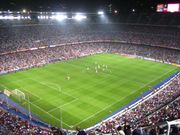
Sport is mainly the responsibility of individual states or other international organisations rather than that of the EU. However, some EU policies have had an impact on sport, such as the free movement of workers which was at the core of the Bosman ruling, which prohibited national football leagues from imposing quotas on foreign players with European citizenship.
Under the proposed Treaty of Lisbon sports would be given a special status which would exempt this sector from much of the EU's economic rules. This followed lobbying by governing organisations such as the International Olympic Committee and FIFA, due to objections over the applications of free market principles to sport which led to an increasing gap between rich and poor clubs.
Several European sports associations are consulted in the formulation of the EU's sports policy, including FIBA, UEFA, EHF, IIHF, FIRA and CEV. All EU member states and their respective national sport associations are participating in European sport organisations such as UEFA.


